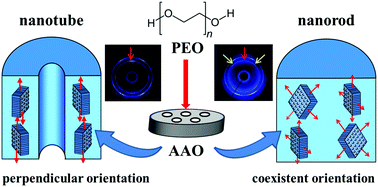Crystal orientation of PEO confined within the nanorod templated by AAO nanochannels†
Abstract
The orientation of poly(ethylene oxide) (PEO) crystallites developed in the nanochannels of anodic aluminum oxide (AAO) membrane has been investigated. PEO was filled homogeneously into the nanochannels in the melt state, and the crystallization confined within the PEO nanorod thus formed was allowed to take place subsequently at different temperatures. The effects of PEO molecular weight (MPEO), crystallization temperature (Tc) and AAO channel diameter (DAAO) on the crystal orientation attained in the nanorod were revealed by 2-D wide angle X-ray scattering (WAXS) patterns. In the nanochannels with DAAO = 23 nm, the crystallites formed from PEO with the lowest MPEO (= 3400 g mol−1) were found to adopt a predominantly perpendicular orientation with the crystalline stems aligning normal to the channel axis irrespective of Tc (ranging from −40 to 20 °C). Increasing MPEO or decreasing Tc tended to induce the development of the tilt orientation characterized by the tilt of the (120) plane by 45° from the channel axis. In the case of the highest MPEO (= 95 000 g mol−1) studied, both perpendicular and tilt orientations coexisted irrespective of Tc. Coexistent orientation was always observed in the channels with a larger diameter (DAAO = 89 nm) irrespective of MPEO and Tc. Compared with the previous results of the crystal orientation attained in nanotubes templated by the preferential wetting of the channel walls by PEO, the window of the perpendicular crystal orientation in the nanorod was much narrower due to its weaker confinement effect imposed on the crystal growth than that set by the nanotube.



 Please wait while we load your content...
Please wait while we load your content...